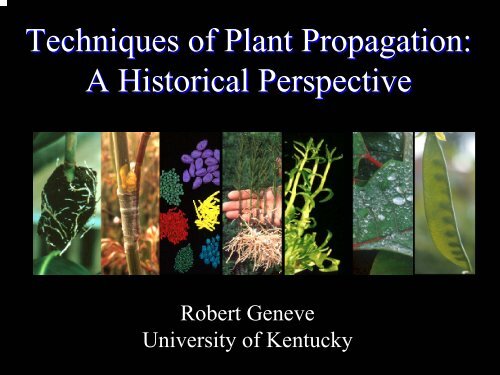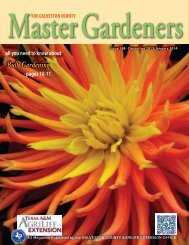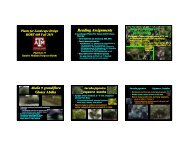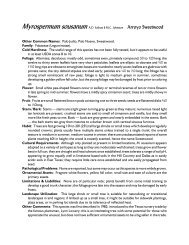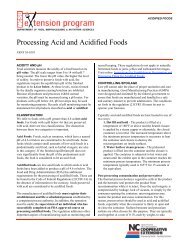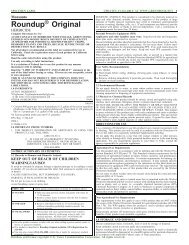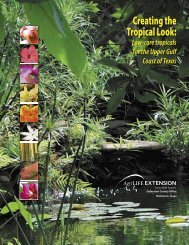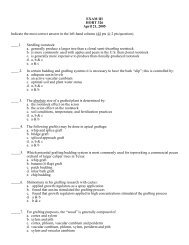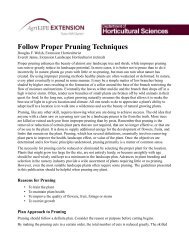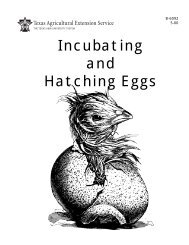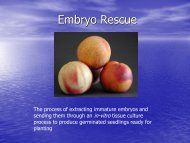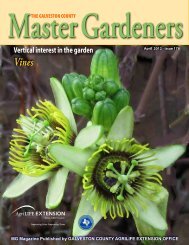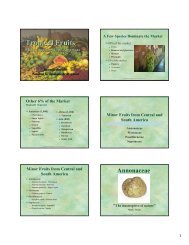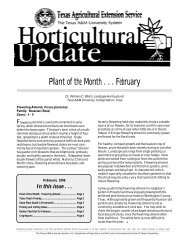History of Plant Prop Techniques (Geneve) - Aggie Horticulture
History of Plant Prop Techniques (Geneve) - Aggie Horticulture
History of Plant Prop Techniques (Geneve) - Aggie Horticulture
Create successful ePaper yourself
Turn your PDF publications into a flip-book with our unique Google optimized e-Paper software.
<strong>Techniques</strong> <strong>of</strong> <strong>Plant</strong> <strong>Prop</strong>agation:<br />
A Historical Perspective<br />
Robert <strong>Geneve</strong><br />
University <strong>of</strong> Kentucky
Theophrastus<br />
Theophrastus was a<br />
Greek philosopher (300<br />
BC) and disciple <strong>of</strong><br />
Aristotle. He described<br />
many aspects <strong>of</strong> plant<br />
propagation in his two<br />
books :<br />
Historia de <strong>Plant</strong>is<br />
and<br />
De Causis <strong>Plant</strong>arum).
Theophrastus<br />
Theophrastus must be<br />
considered the first seed<br />
biologist. He described<br />
seed dispersal in pines.<br />
"While the cones are still<br />
fast to the trees, the seeds<br />
leap forth and leave them<br />
empty."
Hard seeds with impermeable seed coats were also<br />
known to Theophrastus, where he notes that certain<br />
legume seeds need to be treated with<br />
"nitre"(possibly a caustic base)<br />
to germinate.<br />
He also was aware<br />
that the climate<br />
during seed<br />
ripening affected<br />
the degree <strong>of</strong> hard<br />
seeds found at<br />
harvest.<br />
Cross section <strong>of</strong> redbud seed<br />
Malpighian cells
Seed Technology<br />
Modern advances in seed<br />
technology that improve<br />
seedling emergence include<br />
seed priming, coating and<br />
pregermination.<br />
However, from a historical<br />
perspective, these are new<br />
practices based on old<br />
themes.
Primed seeds<br />
Seed Priming<br />
Untreated seeds<br />
Seed Priming is a<br />
controlled seed<br />
hydration treatment<br />
that enhances seed<br />
germination.<br />
Established about<br />
1970.
Seed Priming<br />
Theophrastus (ca. 300 BC)<br />
observed that cucumber<br />
seeds soaked in water prior<br />
to sowing would induce<br />
faster emergence.
Seed Priming<br />
In 1600, Oliver de Serres<br />
described the "clever trick"<br />
<strong>of</strong> soaking grains (wheat,<br />
rye or barley) for two days<br />
in manure water followed<br />
by drying in the shade<br />
before planting the seeds.
Seed Priming<br />
He noted that soaked seeds<br />
emerged more quickly<br />
avoiding "the danger <strong>of</strong><br />
being eaten away by soil<br />
pests" .
Seed Priming<br />
In experiments conducted<br />
in 1855, Charles Darwin<br />
hinted at the possibilities<br />
for osmotic seed priming.
Seed Priming<br />
Darwin submerged seeds<br />
in salt water to show that<br />
they could move across the<br />
sea between landmasses as<br />
a means to explain<br />
geographic distribution <strong>of</strong><br />
plant species.
Seed Priming<br />
Not only did seeds survive<br />
immersion in cold salt<br />
water for several weeks,<br />
but some species like cress<br />
and lettuce showed<br />
accelerated germination.
Seed Pelleting<br />
Seed pelleting is the<br />
practice <strong>of</strong> surrounding<br />
the seed with an inert<br />
material to facilitate<br />
sowing.
Seed Pelleting<br />
Seed pelleting was<br />
practiced in ancient<br />
times as Pliny describes<br />
treating vegetable seeds<br />
in "enclosed pellets <strong>of</strong><br />
goats' dung, each seed in<br />
a separate pellet, they<br />
came up wonderfully".<br />
Pliny the Elder ca. 1 AD
Pregermination<br />
Pregerminated seeds were<br />
introduced commercially in<br />
1995 for bedding plant<br />
species (impatiens), but<br />
Liberty H. Bailey described<br />
the concept as early as 1897.<br />
Liberty Hyde Bailey<br />
1858-1954<br />
Pregerminated<br />
Raw seeds
Pregermination<br />
Liberty Hyde Bailey<br />
1858-1954<br />
“It is a common statement that<br />
seeds can never revive if<br />
allowed to become thoroughly<br />
dry after they have begun to<br />
sprout. This is an error. Wheat,<br />
oats, buckwheat, maize, pea,<br />
onion, radish and other seeds<br />
have been experimented upon<br />
in this direction,
Pregermination<br />
and they are found to<br />
regerminate readily, even if<br />
allowed to become<br />
thoroughly dry and brittle<br />
after sprouting is well<br />
progressed. They will even<br />
regerminate several times.”<br />
Liberty Hyde Bailey<br />
1858-1954
Seed anatomy<br />
Seed and plant structure<br />
became well documented<br />
after the 1600’s.
Seed anatomy<br />
The Italian Marcelli<br />
Malpighii (1675)<br />
became the first seed<br />
anatomist.
Seed anatomy<br />
Marcelli Malpighii<br />
(1675)<br />
Common bean<br />
Phaseolus
Seed anatomy<br />
Marcelli Malpighii<br />
(1675)<br />
Cucumber<br />
Cucumis
Seed anatomy<br />
Marcelli Malpighii (1675)<br />
Maple samara<br />
Acer
Seed anatomy<br />
Julius Sachs<br />
1886<br />
Shephard’s purse<br />
Capsella
Seed anatomy<br />
Julius Sachs<br />
1886<br />
Simple flower
Cutting propagation
Juvenility<br />
Theophrastus describes<br />
propagation by both stem<br />
and root cuttings. In his<br />
description <strong>of</strong> taking stem<br />
cuttings in olive, he makes<br />
a reference to the concept<br />
<strong>of</strong> juvenility as it relates to<br />
rooting. He recommends<br />
taking cuttings from the<br />
base <strong>of</strong> the tree rather than<br />
the tops.
Juvenility<br />
The Roman, Columella (ca. 1 AD) in great detail<br />
describes taking mallet stem cuttings in grape. A<br />
mallet cutting is a combination <strong>of</strong> current and<br />
previous season's stem growth. He states that<br />
cuttings root better when taken from non-fruiting<br />
wood.
Auxin<br />
Although the concept <strong>of</strong> auxin<br />
and its ability to stimulate<br />
rooting in cuttings is a modern<br />
concept. Theophrastus describes<br />
improved rooting in fig cuttings<br />
by setting them in squill bulbs.
Willow extract<br />
Dr. M. Kawase proposed using willow extract to<br />
improve rooting in 1971. However, Agricola<br />
(1721) described drilling holes in a willow branch<br />
into which stem cuttings <strong>of</strong> other species were<br />
inserted prior to planting them for propagation.
Thomas Barnes<br />
1758<br />
"The occasion and purpose<br />
<strong>of</strong> this work. The difficulty<br />
<strong>of</strong> propagating some shrubs<br />
in the common way, and<br />
the small increase that can<br />
be made from others by the<br />
usual methods, brought into<br />
my thoughts to try whether<br />
some expeditious manner<br />
could not be invented <strong>of</strong><br />
raising a large number.”
Thomas Barnes<br />
1758<br />
"Every nurseryman will be<br />
glad to know this: for if he<br />
can, when he has got a new<br />
shrub, raise twenty or thirty<br />
instead <strong>of</strong> three or four, it<br />
will be a great increase for<br />
his pr<strong>of</strong>it. This made me<br />
resolve not to be<br />
disheartened at one or two<br />
trials.”
Thomas Barnes<br />
1758<br />
" Not trusting to one or two<br />
samples <strong>of</strong> each, but using<br />
several dozens <strong>of</strong> every<br />
kind, and trying them in all<br />
the different conditions <strong>of</strong><br />
culture. I kept a journal <strong>of</strong><br />
them all, which I have here<br />
faithfully transmitted to the<br />
publick; every one will see<br />
how far each method<br />
succeeded, and which<br />
deserves the preference.”
Thomas Barnes<br />
1758<br />
" Melt together, in a large<br />
earthen pipkin, two pound<br />
and an half <strong>of</strong> common<br />
pitch, and half a pound <strong>of</strong><br />
turpentine. When melted<br />
put in three quarters <strong>of</strong> an<br />
ounce <strong>of</strong> powder <strong>of</strong> aloes;<br />
stir them all together; and<br />
set the matter on fire; when<br />
it has flamed a moment,<br />
cover it up close, and it will<br />
go out.”
Thomas Barnes<br />
1758<br />
" This must be done three<br />
times : it must be done in<br />
the open air, for it would<br />
fire a house. Melt it again,<br />
and put in three ounces <strong>of</strong><br />
yellow wax shred very thin,<br />
and six drams <strong>of</strong> mastich in<br />
powder. Strain it through a<br />
coarse cloth into a pan, and<br />
set it by to cool .”
Mist <strong>Prop</strong>agation<br />
Experimentally available in 1940’s<br />
Commercially practiced in late 1950’s
<strong>Prop</strong>agation Environment<br />
Bell jars.
<strong>Prop</strong>agation Environment<br />
<strong>Prop</strong>agation boxes<br />
and Wardian cases.
<strong>Prop</strong>agation Environment<br />
Bottom heat<br />
L.H. Bailey’s Nursery Book 1891
<strong>Prop</strong>agation Environment<br />
Bottom heat<br />
L.H. Bailey’s Nursery Book 1891
Frames<br />
<strong>Prop</strong>agation Environment
Cloche<br />
<strong>Prop</strong>agation Environment
<strong>Prop</strong>agation Environment<br />
Hot Frame
Subirrigation<br />
Kenneth Post’s Florist Crop Production and Marketing 1959
Subirrigation<br />
Kenneth Post’s Florist Crop Production and Marketing 1959
Layering
Philip Miller<br />
Gardeners Dictionary<br />
1754<br />
"Take some <strong>of</strong> the boughs, and lay them into the<br />
ground about half a foot deep in fine fresh mould,<br />
leaving them with the end <strong>of</strong> the layer about a foot,<br />
or a foot and an half, out <strong>of</strong> the ground, and keep<br />
them moist during the summer season, and they<br />
will probably have taken, and be fit to remove, in<br />
autumn.”
Philip Miller<br />
Gardeners Dictionary<br />
1754<br />
"Tie a piece <strong>of</strong> wire hard round the bark <strong>of</strong> the<br />
bough, at the place you intend to lay in the ground;<br />
prick the place above the wire thro' the bark with<br />
an awl in several places, and then lay it in the<br />
ground, as before directed.”
"cut a slit upwards at a<br />
joint, as is practised in<br />
laying <strong>of</strong> carnations,<br />
Philip Miller<br />
which by gardeners<br />
is called tonguing<br />
the layers.”
Simple Layering<br />
Charles Baltet 1903
Compound Layering
Air Layering
Pot Layering
Philip Miller<br />
Gardeners Dictionary<br />
1754<br />
"If … the boughs <strong>of</strong> which cannot be bent down to<br />
the ground, then you must make use <strong>of</strong> osierbaskets,<br />
boxes, or pots, fill'd with fine-sifted<br />
mould, mix'd with a little rotten willow-duft,<br />
which will keep moisture and assist the layer in<br />
taking root.”
Charles Baltet 1903
Graftage
Theophrastus (ca. 300 BC)<br />
on wedge grafting<br />
"… after splitting the stock and<br />
giving the scion a wedge-like<br />
shape then drive it in with a<br />
mallet to make the fit as tight as<br />
possible. Then to avoid having<br />
the graft dry out. ”<br />
"… first bandage the site with layers <strong>of</strong> lime bark and<br />
then plaster mud over it mixed with hair : to make the<br />
fluid remain and keep sun, rain and cold from doing<br />
any harm.”
Columella (ca. 1 AD)<br />
He describes one <strong>of</strong> the<br />
first types <strong>of</strong> budding as<br />
his own invention.<br />
Ring or annular budding.
Columella (ca. 1 AD)<br />
" … also choose the<br />
healthiest branch <strong>of</strong> the<br />
other tree, which you are<br />
going to inoculate, and cut<br />
out a part <strong>of</strong> the bark <strong>of</strong><br />
the same dimensions…<br />
Then fit the scutcheon<br />
which you prepared to the<br />
part which you have<br />
bared.”
Robert Sharrock<br />
1672<br />
In a single figure from<br />
the “<strong>History</strong> <strong>of</strong> the<br />
<strong>Prop</strong>agation and<br />
Improvement <strong>of</strong><br />
Vegetables”, Sharrock<br />
demonstrates that most<br />
current grafting and<br />
budding techniques<br />
were in practice in the<br />
1600’s.
Georg Andreas Agricola 1716
Georg Andreas Agricola 1716
Grafting tools<br />
Georg Andreas Agricola 1716
Georg Andreas Agricola<br />
1716
Philip Miller (1754)<br />
Approach grafting<br />
"This method <strong>of</strong> grafting is<br />
used, when the stock you<br />
intend to graft on, and the<br />
tree from which you would<br />
take the graft, stand so near<br />
(or can be brought so near),<br />
that they may be joined<br />
together.”
Philip Miller (1754)<br />
Approach grafting<br />
"pare away the rind and the<br />
wood on one side about<br />
three inches in length…<br />
then cut a little tongue<br />
upward in the graft, and<br />
make a notch in the stock to<br />
admit it… the tongue will<br />
prevent their flipping, and<br />
the graft will more closely<br />
unite with the stock.”
Philip Miller (1754)<br />
Approach grafting<br />
"You must tie them with some<br />
… s<strong>of</strong>t tying; then cover the<br />
place with grafting clay, to<br />
prevent the air from entering<br />
to dry the wound. This<br />
operation is always performed<br />
in April or May.”
Philip Miller (1754)<br />
Approach grafting<br />
”It is commonly practiced<br />
upon oranges, myrtles,<br />
jasmines, walnuts, firs<br />
pines, and several other<br />
trees, which will not<br />
succeed by common<br />
grafting or budding.”
Charles Baltet 1903
Charles Baltet<br />
1903
P. Thouin<br />
Monographic des Greffes<br />
ou Description<br />
<strong>Techniques</strong><br />
1921
Charles Baltet<br />
1903
Joseph Curtis (1786 - 1882)<br />
One grafting type was<br />
originated in the USA. Joseph<br />
Curtis (1786 - 1882) from<br />
Manchester, Ohio was grafting<br />
fruit trees at the age <strong>of</strong> 16. At<br />
that time, understocks for fruit<br />
trees was in limited supply. He<br />
decided to use root pieces for<br />
understocks in apple grafting<br />
and thus developed the method<br />
<strong>of</strong> root grafting.”
Dwarfing understocks<br />
Dwarfing understocks were developed at the East<br />
Malling experiment station in England during the<br />
early 1900's. However, using dwarfing stocks was<br />
described by Philip Miller (1754) as common<br />
practice over onehundred<br />
years<br />
previous where he<br />
mentions Dutch<br />
dwarf-stock or<br />
Dutch Paradiseapple.
Dwarfing understocks<br />
"Apples are grafted or budded upon stocks raised<br />
from seeds which come from the cyder-press, or<br />
upon crab-stocks, … but for small gardens, the<br />
paradise-stock hath been for some years past greatly<br />
esteem'd; it being <strong>of</strong><br />
very humble growth,<br />
causeth the fruittrees<br />
grafted, and<br />
kept in small<br />
compass.
Charles Baltet 1903
Charles Baltet 1903
Charles Baltet 1903
Charles Baltet 1903
Charles Baltet 1903
Charles Baltet 1903
Nurse<br />
graft<br />
Charles Baltet<br />
1903
Topworking<br />
in Kiwi
Scoop Graft<br />
R. J. Garner (1949) The Grafter’s Handbook
Biotechnology vs. Grafting<br />
Genetic engineering crop<br />
plants has become a<br />
controversial subject. To<br />
the general public, this<br />
procedure for crop<br />
improvement is unnatural<br />
and it is viewed with<br />
suspicion.<br />
Could grafting have ever evoked similar emotions
Grafting<br />
Liberty Hyde Bailey<br />
1858-1954<br />
"To the popular mind there<br />
seems to be something<br />
mysterious in the process <strong>of</strong><br />
graftage. People look upon<br />
it as something akin to<br />
magic, and entirely opposed<br />
to the laws <strong>of</strong> nature. It is<br />
popularly thought to<br />
represent the extreme power<br />
which man exercises over<br />
natural forces."
Grafting<br />
Liberty Hyde Bailey<br />
1858-1954<br />
"Grafting is in effect a kind<br />
<strong>of</strong> adulteration … grafting<br />
and budding will have to be<br />
abandoned, and real work<br />
must be begun on some<br />
sound and sensible plan.<br />
Any fruit-bearing or<br />
ornamental tree that will not<br />
succeed on its own roots had<br />
better go to the rubbish fire<br />
at once."
Grafting<br />
"But the whole discussion <strong>of</strong><br />
the mere naturalness <strong>of</strong> any<br />
operation is really aside<br />
from the question, for every<br />
operation in the garden is in<br />
some sense unnatural."<br />
Liberty Hyde Bailey<br />
1858-1954
Grafting<br />
Liberty Hyde Bailey<br />
1858-1954<br />
"It is impossible, if one<br />
considers the facts broadly<br />
and candidly, to arrive at<br />
any other conclusion than<br />
this: graftage is not suited to<br />
all plants, but in those to<br />
which it is adapted - and<br />
they are many - it is not a<br />
devitalizing process."
New form <strong>of</strong> Cotton<br />
Gerard’s Herbal 1597
Spontaneous<br />
Generation<br />
Barnacle tree<br />
Gerard’s Herbal 1597
<strong>Techniques</strong> <strong>of</strong> <strong>Plant</strong> <strong>Prop</strong>agation:<br />
A Historical Perspective<br />
Robert <strong>Geneve</strong><br />
University <strong>of</strong> Kentucky


